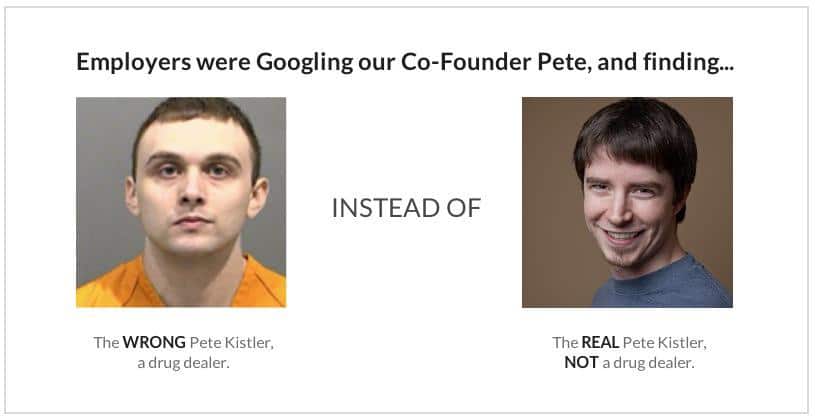When I was in college (back before our civilized, digital epoch had dawned), the resume was the “you” you presented to potential employers. It was a carefully crafted document, edited to put your experience and skills in the best possible light. It was quite efficient, and the primary filter that companies used to screen applicants.
Flash forward about 20 years and the resume has almost taken a back seat to the digital identity prospective employers can glean about you from lots of sources, not just your ever so carefully crafted resume.
In today’s digital world, your digital identity is the now the “you” companies see well before they even invite you in for an interview. And yet, in today’s digital world, the digital “you” can misrepresent “you” in ways unimagined. And unfortunately, this is something that happens more frequently than you would think.
That reality became a rude awakening to a Syracuse College kid when, as he approached graduation, started to canvass for work. Pete Kistler was having a hard time even getting an internship even though he was one of the most qualified kids in the class. His GPA was nearly perfect, he had started two clubs on campus and he had even won a few scholarships. He sent his resume to dozens of companies, and while other kids were going on interviews, and lining up gigs, Pete wasn’t hearing from anyone.
He had no idea why—until a former classmate who worked at a company that rejected him explained: “Once they got your resume, they Googled you.” Turns out, potential employers were finding Pete Kistler, a drug dealer with the same name, and they assumed that was him.
What a kick in the head this was since Pete had no idea how to fix it. Sure, there were “digital reputation” companies out there, but they are meant mainly for businesses, and they would charge thousands of dollars to fix it for him. Plus, the results weren’t assured. In other words, Pete was living under the cloud of a criminal, and he knew he had to do something about it.
So while still in college, Pete and his buddy Patrick Ambron started a tech “digital identity clean up” company called BrandYourself. It is a free DIY product that helps you improve your own search results. They continued to innovate to create a platform that lets real people manage what the world sees about their digital identity.
Pete learned the hard way that leaving your Google results to – er – Google – was risky, especially since according to a recent national study, 85% of hiring managers solidify their decision to hire someone based on positive Google results. Worse, 70% of hiring managers solidify their decision not to hire based on negative ones.
With that much at stake, you can’t leave it to Google chance to make sure your digital identity reflects “you.” Here are six steps you can take today to get started.
6 Steps To Prevent Digital Identity Disaster
1. Google Yourself
The first step is easy – Google yourself. See what’s out there about you – good, bad or indifferent. Once you know the results for your name, you can take action (see below). You can also use the free version of BrandYourself (if you have the appetite).
2. Claim Your Domain Name
Before you do anything else, visit a domain registrar like Hover.com and purchase all domains containing your name (e.g., yourname.com, yourname.me). It’s the most important thing you can do, and it only costs 12 bucks a year. Domain names show up high in searches for your name, so this is the fastest, easiest way to get a result on the first page of Google. Even if you’re not planning to create a personal website right away, you’ll at least prevent other people with your name from stealing your results.
If someone has taken your name, don’t worry. First check to see if all variations are taken: yourname.me, yourname.org, yourname.tv, etc. If they are, choose a domain that still includes your full name together. For example: Judy-Shapiro.com, JudyShapiroblog.com, etc are all better than JudShap.com. Point is, even if you’re name is John Smith you can find some domain name that will include your name.
3. Build A Personal Website
You should have at least one hub on the web that showcases everything about you—your work history, education, accolades, personal interests, and so on. Hint: The more comprehensive you make it, the higher it will show up in Google. With free tools like WordPress and Tumblr that let you set up and maintain your site pretty easily, there is absolutely no excuse not to have one. If you’re really serious about owning your first page (like you’re trying to bury, say, a drug dealer) create multiple hubs. The more content you have in Google, the better.
4. Get On The Four Main Social Networks
That’s Facebook, LinkedIn, Twitter, and Google+. (In fact, the more social media profiles you create—think Pinterest, Reddit, Instagram—the better.) These are credible sites that Google trusts, so they tend to rank very high for your name.
You don’t need to be super active on these sites—just create a profile and fill out all of the fields, and that’s another positive result you control. Again, you’re also claiming your name so that other people with the same name don’t beat you to it and get that result instead. If they do beat you to it, just try to create a username that still includes your name (Judy-Shapiro, JudyShapiroPR, etc). Then make sure you optimize it (see below).
5. Do Basic Search Engine Optimization (SEO)
Now that you have a website, domain and social media profiles, make sure they’re “search engine optimized.” While SEO can be complicated, there a few basic things you can do that will make a big difference:
- Use your actual name wherever possible: Quite simply, if your name isn’t found on a page, Google won’t consider that page a relevant result when people search your name. That means use “Judy Shapiro” not “JudShap”.
- Fill your profiles out completely: You might notice people often leave their Facebook profiles’ “About” section blank. While it may not be important to you personally, the more information about you on a page, the more likely Google is to rank it higher. So complete your LinkedIn profile 100%, add in your Twitter bio, and fill out every section you can on Facebook. It will make a difference.
- Link them all together: Make sure that all of your profiles and webpages link to each other. When I find your LinkedIn profile, I should be able to get from there to your website. When I get to your website, I should be able to find everything else, and so on. Google counts every link to a page as a vote for that page’s credibility, so the more relevant pages about you that link together, the higher they’ll all rank.
6. Monitor Your Results
Even if you look great now, it only takes one poorly judged photo tag or a blog post from a disgruntled partner to ruin your search results. Either Google yourself on a regular basis (you can create a Google Alert for free) or use a tool like BrandYourself that will alert you when things change and tell you what you can do about it.
Take it from Pete – you definitely don’t want to leave your Google results to chance. That’s why it is a good idea to put your digital identity in your hands. It’s critical maintenance your ID needs that let’s “you” be “you” in today’s digital landscape.
Header Image Credit: [The University of Adelaide]


COMMENTS